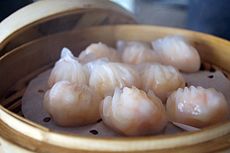food.wikisort.org - Dish
Har gow (sometimes anglicized as "ha gow", "haukau", "hakao"; Chinese: 蝦餃; Cantonese Yale: hā gáau; pinyin: xiājiǎo) is a traditional Cantonese dumpling served as dim sum.[1]
 | |
| Alternative names | Xia jiao, also spelled ha gau, ha gaau, ha gao, ha gow, or other variants, Vietnamese "há cảo" |
|---|---|
| Course | Dim sum |
| Place of origin | Guangdong, China |
| Region or state | Cantonese-speaking region |
| Main ingredients | Wheat starch, tapioca starch, shrimp, cooked pork fat, bamboo shoots, scallions, cornstarch, sesame oil, soy sauce, sugar, and other seasonings |
| Har gow | |||||||||||||||||||||||
|---|---|---|---|---|---|---|---|---|---|---|---|---|---|---|---|---|---|---|---|---|---|---|---|
| Chinese name | |||||||||||||||||||||||
| Traditional Chinese | 蝦餃 | ||||||||||||||||||||||
| Simplified Chinese | 虾饺 | ||||||||||||||||||||||
| Jyutping | haa¹ gaau² | ||||||||||||||||||||||
| Cantonese Yale | hā gáau | ||||||||||||||||||||||
| Hanyu Pinyin | xiājiǎo | ||||||||||||||||||||||
| Literal meaning | shrimp dumpling | ||||||||||||||||||||||
| |||||||||||||||||||||||
| Vietnamese name | |||||||||||||||||||||||
| Vietnamese | há cảo | ||||||||||||||||||||||
| Thai name | |||||||||||||||||||||||
| Thai | ฮะเก๋า [háʔ.kǎw] | ||||||||||||||||||||||
| RTGS | hakao | ||||||||||||||||||||||
Name
The dumpling is sometimes called a shrimp bonnet for its pleated shape. This dish is often served together with siumaai; when served in such a manner the two items are collectively referred to as gar gow-siu mai (Chinese: 蝦餃燒賣; pinyin: xiājiǎo shāomài; Cantonese Yale: hā gáau sīum áai).[2][3]
Har gow, siu mai, cha siu bao, and egg tarts are considered the classic dishes of Cantonese cuisine and referred to as The Four Heavenly Kings. (Chinese: 四大天王; pinyin: sì dà tiān wáng; Cantonese Yale: sei daaih tīn wòhng).[4][5]
The name in Cantonese also means "wedding gown" as the shape of the dumpling resembles the traditional gown worn by a woman on her wedding day.[6]
Description
These shrimp dumplings are transparent and smooth. The prawn dumplings first appeared in Guangzhou outskirts near the creek bazaar Deli. This dish is said to be the one that the skill of a dim sum chef is judged on. Traditionally, ha gow should have at least seven and preferably ten or more pleats imprinted on its wrapper. The skin must be thin and translucent, yet be sturdy enough not to break when picked up with chopsticks. It must not stick to the paper, container or the other ha gow in the basket. The shrimp must be cooked well, but not overcooked. The amount of meat should be generous, yet not so much that it cannot be eaten in one bite.
See also
- Dim sum
- Shumai
References
- Hsiung, Deh-Ta. Simonds, Nina. Lowe, Jason. [2005] (2005). The food of China: a journey for food lovers. Bay Books. ISBN 978-0-681-02584-4. p41.
- Big5.China.com.cn. "China.com.cn." 廣州茶飲. Retrieved on 2009-03-17.
- Yahoo.com. "Yahoo.com Archived 2008-04-04 at the Wayback Machine." 街坊盅頭飯. Retrieved on 2009-03-15.
- Talks, Honest Food (2020-02-05). "Dim Sum, a Beginner's Guide to the Cantonese Cuisine". Honest Food Talks. Retrieved 2020-10-30.
- "广州早茶"四大天王"有哪些?". www.sohu.com. Retrieved 2020-10-30.
- "Raviolis aux crevettes à la vapeur (Ha Kao)" (in French). Retrieved 2021-12-28.
Другой контент может иметь иную лицензию. Перед использованием материалов сайта WikiSort.org внимательно изучите правила лицензирования конкретных элементов наполнения сайта.
WikiSort.org - проект по пересортировке и дополнению контента Википедии


